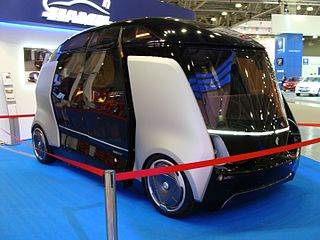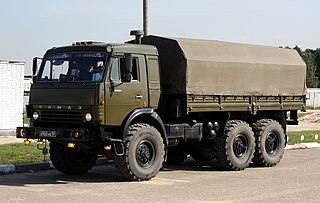 W
WJSC KAMAZ is a Russian brand of trucks and engines manufacturer located in Naberezhnye Chelny, Russia. It is famous for its cab over trucks. KAMAZ is a portmanteau which stands for a factory on the Kama River.
 W
WKAMAZ-7850 (Platforma-O) is a new unified family of wheeled very heavy load transporters developed by KAMAZ for the Russian Ministry of Defence. It will replace the Belarusian-made MZKT transporter erector launchers that are currently carrying Russian ICBMs. Platforma-O comprises KAMAZ-7850 16x16 vehicle with a capacity of 85 t, KAMAZ-78509 12x12 with a capacity of 60 t, KAMAZ-78504 8x8 capable for towing of a 90 t semi-trailer, and KAMAZ-78508 8x8 for the transportation of aircraft on airfields. One of the applications will be carrying RS-24 Yars missiles. State tests were completed in August 2018 and it entered service in March 2019. The Russian military is to receive five versions of the vehicle, namely, 8x8, 12x12 and 16x16 heavy transporters with payload capacities of 25 t, 50 t, and 85 t, respectively, an 8x8 semi-trailer with a towing capacity of 165 t, and an 8x8 ballast tractor with a towing capacity of 400 t. The 12x12 and 16x16 tractors will be used as transporter erector launchers, while other vehicles will carry various support systems.
 W
WThe BPM-97 or Выстрел is the Russian military designation for the KAMAZ 43269 Vystrel 4×4 wheeled mine-resistant, ambush protected (MRAP) vehicle. It is produced fitted with several different turrets like the one of the BTR-80A. The vehicle is based on the KAMAZ-43269 and as the name suggests was designed for the Russian Border Guards. The latest model has bulletproof side windows and no gun turret. It has been ordered by Kazakhstan and by the National Guard of Russia, Federal Prison Service and EMERCOM.
 W
WKamAZ "Shuttle" - an electric bus with autopilot. Joint development by the AERI and the KamAZ Automobile Plant. It was first presented at the Moscow International Automobile Salon in 2016.
 W
WKamaz Typhoon is a family of Russian multi-functional, modular, armoured MRAP vehicles manufactured by the Russian truck builder Kamaz. The Typhoon family is part of Russia's Typhoon program. As of 2021, the number of Typhoons in the Russian Armed Forces fleet is about 330 units of Typhoon-K.
 W
WThe KamAZ-4310 is an all-wheel drive truck produced by Kamaz in Naberezhnye Chelny. The vehicle was built in series in different versions from 1981 to 1995, a very similar successor is still on the market today with the KamAZ-43114, also in different versions.
 W
WThe KamAZ-4326 is a four-wheel drive truck produced by Kamaz in Naberezhnye Chelny. The vehicle has been in production since 1995 and is also designed for military applications. With the KamAZ-4350, there is a modernized successor. The KamAZ-43114 is very similar to the KamAZ-4326, but has three axes instead of two.
 W
WThe KamAZ-4350, also known as "Mustang", is a four-wheel drive truck produced by Kamaz in Naberezhnye Chelny. The vehicle has been in production since 2003 and is also designed for military applications. With the KamAZ-43501, there is a version with a slightly lower payload.
 W
WKamAZ-6282 is the urban large class low-floor electric bus codeveloped by NefAZ and KamAZ. Mass production of this model began in 2018.
 W
WThe KamAZ-43114 is an all-wheel drive truck produced by Kamaz in Naberezhnye Chelny. The vehicle was developed from 1991 and has been in series production since 1995. The main difference between the model and its predecessor, the KamAZ-4310, is a more powerful engine.
 W
WThe SBA-60K2 Bulat armored personnel carrier (APC) was developed jointly by Kamaz and Zaschita corporation as a private venture. Development of this vehicle commenced in 2010 and was completed by 2013. It is a further development of the earlier BPM-97 6x6 wheeled mine-resistant, ambush protected (MRAP) vehicle. Russia currently employs 15 Bulat vehicles received in late 2014, and ordered a new batch of further 50 vehicles from the Russian manufacturer Zashcita.
 W
WThe Lada Оkа is a city car designed in the Soviet Union in the later part of the seventies by AvtoVAZ. It entered production in 1988 powered by a 644 cc (39.3 cu in) SOHC two-cylinder engine. While developed at AutoVAZ by a team led by Yuri Kuteev, no production models were built there. Instead, manufacturing was outsourced to SeAZ factory in Serpukhov and ZMA in Naberezhnye Chelny. Massive plans were in place for a new plant in Yelabuga, but these failed to materialize. The car was also produced in Azerbaijan by the Gyandzha Auto Plant. The name comes from the Oka River in Russia upon which Serpukhov is situated.